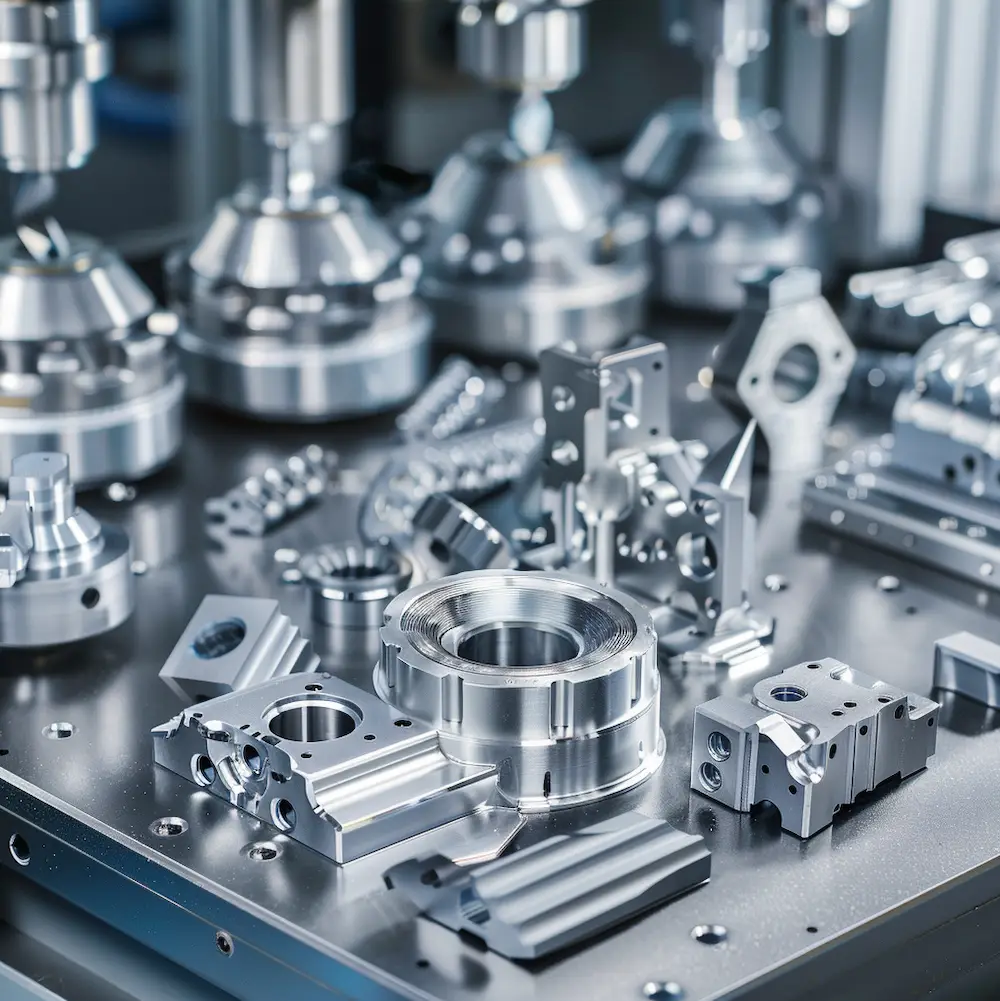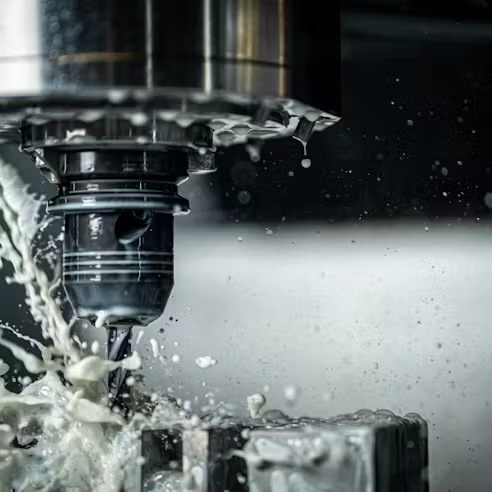In CNC machining, achieving the perfect balance between cutting speed and feed rate is essential for producing high-quality parts at optimal costs. By fine-tuning these parameters, manufacturers can increase productivity, reduce tool wear, and improve the surface finish of their products. As a trusted CNC machining service provider based in China, CNCRUSH specializes in CNC milled parts and CNC turned parts with over 12 years of experience in precision machining. In this article, we explore the best practices for CNC machining cutting speed and feed rates, backed by expert insights, and how manufacturers like you can leverage these practices to enhance your operations.

Cutting Speed vs. Feed Rate: What’s the Difference?
Before diving into best practices, it’s crucial to understand the distinction between cutting speed and feed rate, two fundamental factors that determine the quality of CNC machining.
Cutting Speed is the rate at which the cutting tool moves through the material. It is usually expressed in surface feet per minute (SFM) or meters per minute (MPM). The cutting speed depends on the material being machined, the tool’s material, and the tool’s diameter. A higher cutting speed typically improves the efficiency of machining but may increase tool wear.
Feed Rate refers to the speed at which the tool moves through the material during the cutting process, measured in inches per minute (IPM) or millimeters per minute (MPM). It’s directly tied to the precision of the cut. The correct feed rate ensures the tool remains engaged with the material, leading to better surface finishes and reduced tool wear.
To get the most out of your CNC machining process, balancing both cutting speed and feed rate is critical.
1. Optimizing Cutting Speed for CNC Milled Parts and CNC Turned Parts

When it comes to CNC milled parts or CNC turned parts, optimizing cutting speed is one of the first steps toward improving efficiency. The right cutting speed ensures that the tool performs at its best while minimizing heat and tool wear. Here’s how you can optimize cutting speed for different materials:
- Aluminum: Aluminum alloys are typically machined at higher cutting speeds due to their softness and heat conductivity. This allows for faster processing without excessive tool wear.
- Steel: Steel, especially harder grades, requires lower cutting speeds compared to aluminum. However, using high-performance cutting tools can still achieve high speeds while maintaining quality.
- Plastics: For CNC machining, cutting speed should be adjusted to avoid melting or warping the material. A slower cutting speed helps in achieving a clean cut without damaging the workpiece.
Best Practice: Always refer to your tool manufacturer’s recommendations for cutting speeds. Fine-tuning based on the material and tooling is key.
2. Feed Rate and Its Impact on Tool Life and Surface Finish
Feed rate plays a significant role in the quality of the machined part. A higher feed rate may improve productivity but can result in a rougher surface finish and faster tool wear. Conversely, a slower feed rate leads to finer finishes but can increase machining time.
For CNC milled and CNC turned parts, adjusting the feed rate based on the material, cutting tool, and desired finish is crucial:
- Low feed rate: Ideal for softer materials like aluminum to create smoother finishes.
- High feed rate: Suitable for harder materials or when rough cuts are needed, but may compromise the surface finish.
Best Practice: Begin with the recommended feed rates and adjust based on the actual results you observe in your production.
3. Matching Spindle Speed with Feed Rate
Spindle speed and feed rate need to be compatible to avoid complications during machining. An improperly set spindle speed can result in issues like poor surface finishes, excessive tool wear, or even part damage. Spindle speed determines how quickly the tool rotates, while feed rate dictates how fast the tool moves across the workpiece. Both need to be balanced for optimal performance.
Best Practice: Use a ratio between spindle speed and feed rate that corresponds to the type of material being machined and the tooling used. For example, when machining harder materials, use a lower spindle speed with a slower feed rate.
4. Using the Right Tooling for Optimal Speeds and Feeds
The choice of tooling directly impacts both cutting speed and feed rate. For instance, carbide tools can handle higher speeds and feed rates compared to high-speed steel (HSS) tools. Additionally, the tool’s geometry (such as its cutting edge angle) affects its ability to handle specific feed rates.
For CNC milled parts, using the correct tool geometry ensures efficient material removal with minimal friction, while for CNC turned parts, selecting the proper inserts helps control chip formation and prolong tool life.
Best Practice: Invest in high-quality tools suited for your material and machining conditions to optimize both speed and feed.
5. Coolant Usage and Its Effect on Cutting Speed

Using the right coolant can make a substantial difference in cutting speed and overall machining efficiency. Coolants reduce heat build-up, improve chip removal, and prolong the life of cutting tools. However, improper coolant application can result in excessive tool wear or part distortion.
Best Practice: Ensure the coolant type and flow rate are appropriate for the material and the machining operation to maximize cutting speeds without damaging the tool or workpiece.
6. The Importance of Chip Load in CNC Machining
Chip load refers to the amount of material a tool removes during each pass. It’s a key factor in determining both cutting speed and feed rate. If the chip load is too high, it can result in tool damage or poor surface finish. Conversely, too low of a chip load can lead to inefficient machining and longer production times.
Best Practice: Maintain a chip load that matches the material and tool to ensure efficient material removal and reduce tool wear.
7. The Role of Machine Stability and Rigidity
Machine stability is a significant factor in maintaining consistent cutting speed and feed rate. CNC machines that are not rigid enough may experience vibrations, leading to inaccurate cuts and reduced tool life. A stable machine environment ensures that cutting conditions remain consistent.
Best Practice: Regularly maintain your CNC machine and ensure that it operates within the manufacturer’s specified tolerances for rigidity.
8. Fine-Tuning Speeds and Feeds for CNC Machining of prototypes
When machining prototypes, precise control over cutting speeds and feed rates is essential for achieving the desired results. Prototypes often require tighter tolerances and more intricate details, so adjusting both parameters ensures that the final part matches the design specifications.
Best Practice: When working on CNC prototype machining, perform test runs and adjust cutting speeds and feed rates to achieve the best balance between quality and speed.
9. Impact of Material Hardness on Cutting Parameters
The hardness of the material being machined directly impacts both cutting speed and feed rate. Harder materials like tool steel require lower cutting speeds and feed rates to avoid excessive tool wear, while softer materials like aluminum allow for faster machining.
Best Practice: Always adjust the cutting speed and feed rate according to the hardness of the material to ensure the best balance of efficiency and tool life.
10. Why Precision CNC Machining Services Are Essential for Quality Parts

For businesses that require high-quality CNC milled and CNC turned parts, the ability to optimize cutting speeds and feed rates is crucial for achieving the desired precision. Whether you’re in the automotive, machine building, or automation industries, working with a reliable CNC machining service provider is key to ensuring that your parts meet exacting standards.
Best Practice: Partner with a CNC machining service provider with the expertise and equipment to optimize cutting parameters for high-precision results.
Table 1: Cutting Speed Recommendations for Different Materials
| Material | Cutting Speed (SFM) | Recommended Tool |
|---|---|---|
| Aluminum | 400-1000 | Carbide |
| Steel | 80-400 | Carbide or HSS |
| Brass | 200-800 | Carbide |
| Plastics | 200-400 | Carbide |
Table 2: Feed Rate Recommendations for Different Materials
| Material | Feed Rate (IPM) | Recommended Tool |
|---|---|---|
| Aluminum | 0.002-0.01 | Carbide |
| Steel | 0.001-0.005 | Carbide or HSS |
| Brass | 0.005-0.02 | Carbide |
| Plastics | 0.01-0.03 | Carbide |
FAQ: CNC Machining Cutting Speed and Feed Rate
Q1: How can I calculate the optimal cutting speed for my CNC machine? A1: The optimal cutting speed depends on the material being machined, the tooling used, and the type of CNC machine. You can calculate it by using the formula:
CuttingSpeed(SFM)=RPM×π×ToolDiameter12
Q2: What happens if my feed rate is too high? A2: If the feed rate is too high, it can cause excessive tool wear, poor surface finish, and possible part damage due to the tool not engaging with the material properly.
Q3: How can CNCRUSH help with my CNC machining needs? A3: CNCRUSH offers high-quality CNC machining services, including CNC milling and turning, specializing in producing precision CNC parts for industries like automotive, machine building, and automation. Our 12 years of experience allow us to offer tailored solutions that maximize efficiency while maintaining the highest standards of quality.
Conclusion
Optimizing cutting speed and feed rates is crucial for producing high-quality CNC milled and turned parts while minimizing costs and tool wear. By following these best practices, CNC machining businesses can enhance production efficiency and ensure superior results for their clients. CNCRUSH, with its expert knowledge and cutting-edge equipment, is committed to delivering high-precision parts for a wide range of industries.
For more insights on CNC machining, visit our website at cncrush.com.
